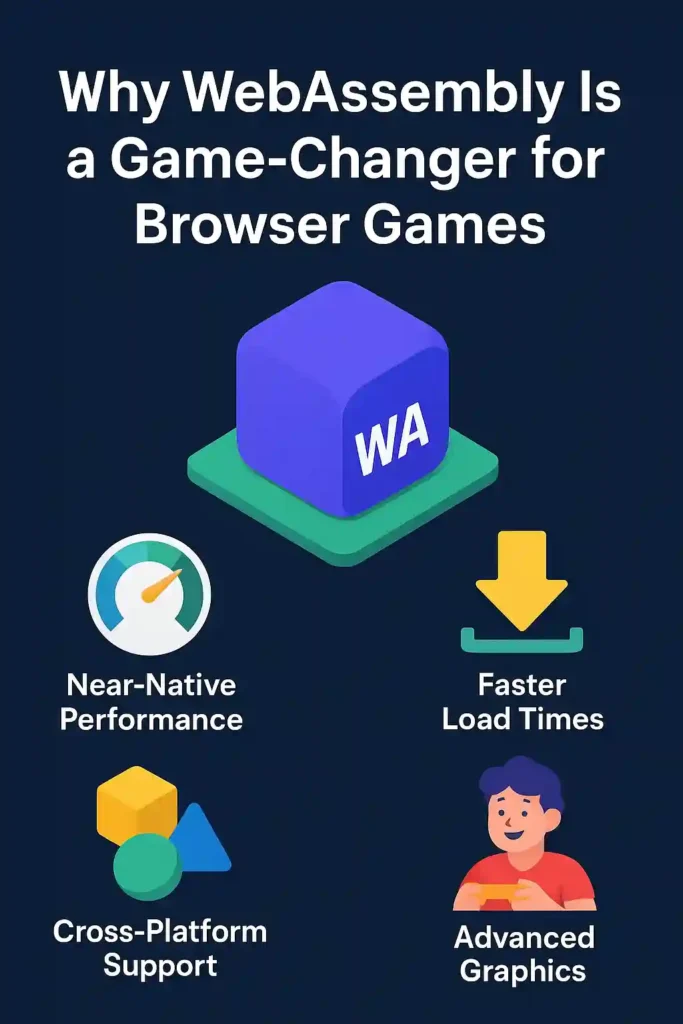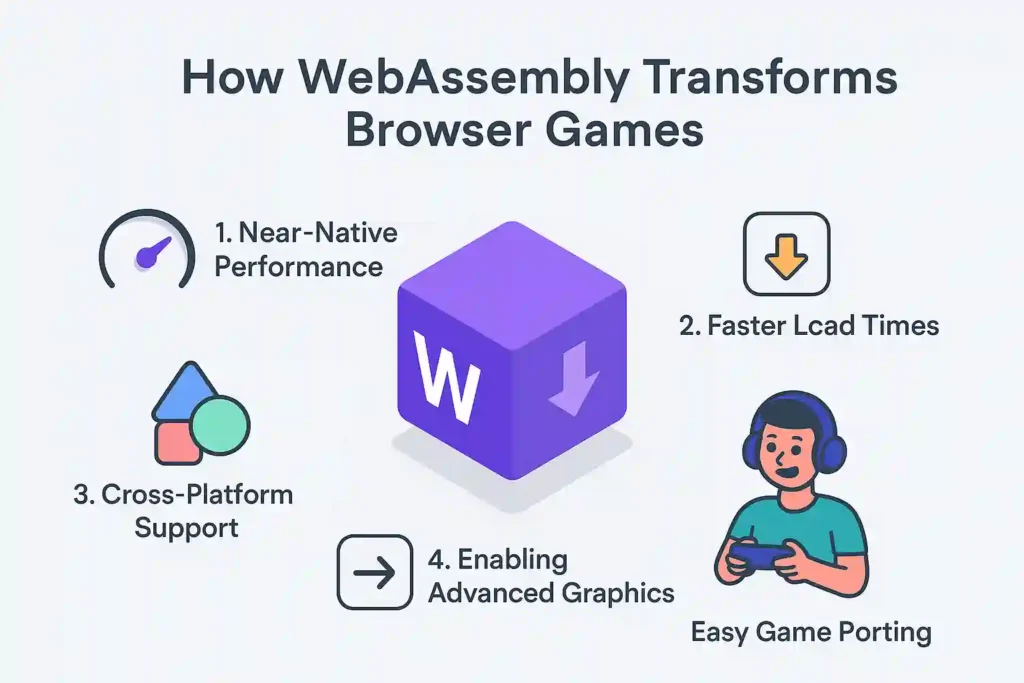Introduction
Browser games have come a long way since the days of Flash animations and simple puzzles. Today, players expect smooth performance, rich graphics, and immersive gameplay directly in their browser—without downloading bulky software. That’s where Web Assembly (Wasm) steps in.
WebAssembly is a low-level, binary instruction format that runs in web browsers. In simple words, it’s like giving your browser superpowers—allowing games to run faster, smoother, and more powerful than ever before.

In this article, we’ll explore what WebAssembly is, how it works, and why it’s revolutionizing browser-based gaming.
What is WebAssembly (Wasm)?
WebAssembly (often shortened to Wasm) is a technology designed to let web applications run code at near-native speed. Instead of relying only on JavaScript, developers can compile code written in languages like C, C++, or Rust into WebAssembly, which the browser can run efficiently.
If JavaScript is the language of the web, WebAssembly is the engine upgrade that makes heavy applications like games, simulations, and 3D graphics run seamlessly.
Learn more on the official WebAssembly.org site.
Why Browser Games Needed WASM
Browser games have always struggled with one big limitation: performance. JavaScript is versatile, but for compute-intensive tasks like 3D rendering, physics simulations, or AI, it often struggles compared to native applications.
With WebAssembly:
Games load faster
Animations are smoother
Complex calculations (e.g., pathfinding, physics) are more efficient
For gamers, this means browser games no longer feel like “light” versions of console or mobile titles. They can be immersive, responsive, and powerful.
How WebAssembly Transforms Browser Games
1. Near-Native Performance
2. Faster Load Times
3. Cross-Platform Support
4. Enabling Advanced Graphics
5. Easy Game Porting

Here are the main reasons why Wasm is a game-changer:
1. Near-Native Performance
Games built with WebAssembly can run almost as fast as desktop applications. For example, a 3D shooter game built in Unity can be exported to WebAssembly and run smoothly inside Chrome or Firefox.
2. Faster Load Times
WebAssembly modules are compact and load much faster compared to bulky JavaScript bundles. This is crucial for keeping players engaged—because no one wants to wait 30 seconds for a game to load.
3. Cross-Platform Support
With Wasm, developers can write code once and run it on multiple platforms: Windows, macOS, Linux, Android, and iOS—all within a browser.
4. Enabling Advanced Graphics
Combined with WebGL and WebGPU, WebAssembly allows browsers to handle complex 3D environments, physics simulations, and VR experiences.
Example: Mozilla’s WebAssembly demo games showcase just how powerful this can be.
5. Easy Game Porting
Existing PC or console games written in C++ can be ported directly into the browser with WebAssembly. This means old favorites and new AAA titles can live on the web.
Real Examples of WebAssembly in Gaming
Unity & Unreal Engine – Both major engines now support exporting games to WebAssembly, making it possible to play complex games in a browser.
AutoDesk & Figma – While not games, these apps show how WebAssembly supports heavy, interactive apps in-browser—proof of its power.
Godot Engine – The open-source engine allows developers to export HTML5/WebAssembly builds for smooth browser play.
Why This Matters for Players
For gamers, WebAssembly means:
Smoother experiences – less lag, faster play.
No downloads – just click and play.
Access anywhere – your favorite game runs on laptop, tablet, or even phone.
Bigger games in the browser – not just casual puzzles, but RPGs, shooters, and simulations.
Why This Matters for Developers
For developers, WebAssembly opens up:
A wider audience – games run in any modern browser.
Lower barriers to entry – no need for players to download 2 GB installers.
Future-proofing – Wasm is backed by major companies like Google, Microsoft, and Mozilla.
Challenges & Limitations of WASM in 2025
Of course, no technology is perfect. Developers working with WebAssembly face some challenges:
Learning Curve: Many indie developers are familiar with JavaScript, but fewer are comfortable with Rust or C++.
Debugging Tools: JavaScript debugging in browsers is mature; WASM debugging is improving but still has rough edges.
Interop Overhead: Passing data between WASM and JS can sometimes slow things down.
Large Module Size: Complex WASM modules can become large, increasing initial download times.
Mobile Constraints: On low-end devices, memory and battery limits can still bottleneck performance.
Still, the positives outweigh the negatives, especially as tooling improves each year.
Real-World Examples in 2025
Unity & Unreal Engine in Browsers
Both Unity and Unreal now support WASM builds, meaning even AAA-style games can run inside browsers with impressive fidelity.Indie Game Developers
Small studios are leveraging WASM to build multiplayer browser games without asking players to install bulky clients.Educational & Serious Games
Learning platforms now use WASM to power 3D simulations, coding challenges, and STEM games directly in browsers.Cloud + WASM Hybrid
Some browser games combine WASM performance with cloud streaming for assets, reducing device strain while still feeling responsive.
The Future of WASM in Browser Gaming
Looking ahead:
WASM 2.0 Features: New capabilities like SIMD instructions and threads will further boost graphics and AI in browser games.
WebGPU Integration: Combined with WASM, WebGPU enables even more advanced rendering (lighting, shadows, physics).
Indie Growth: WASM lowers barriers for small studios to build console-quality games without massive budgets.
Cross-Platform Ecosystem: Imagine playing the same game seamlessly across desktop, mobile browser, and smart TVs—all powered by WASM.
In short, WASM is not just a tool; it’s shaping the future of browser gaming.
FAQs About WebAssembly & Browser Games
Q: What makes WebAssembly faster than JavaScript for gaming?
Because WASM runs pre-compiled binary code, it executes tasks like physics or rendering much more efficiently than JavaScript.
Q: Do all browsers support WebAssembly?
Yes. As of 2025, Chrome, Firefox, Edge, and Safari all support WASM.
Q: Can WebAssembly make browser games as good as console games?
For many casual and mid-core titles, yes. WASM narrows the gap significantly, though ultra-high-end AAA games still push beyond browser limits.
Q: Is WebAssembly secure?
Yes. WASM runs in a sandboxed environment, just like JavaScript, minimizing risks.
Q: Do players need powerful hardware to enjoy WASM games?
Not necessarily. WASM helps optimize performance, but hardware (CPU, GPU, RAM) still matters for the smoothest experience.
Final Thoughts
WebAssembly is not just a buzzword—it’s the future of browser gaming. By delivering near-native performance, enabling advanced 3D graphics, and letting developers port full games to the web, Wasm is unlocking a new era of powerful, accessible gaming.
So next time you play a browser game that feels as smooth as a console experience, chances are—you’ve got WebAssembly to thank.
External References & Suggested Links
Mozilla’s — WebAssembly demo games
WebAssembly 2.0 Arrives — WebFusion Technology
